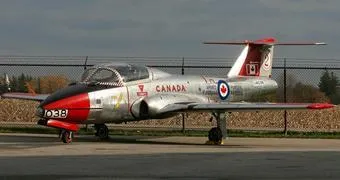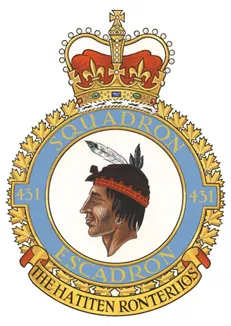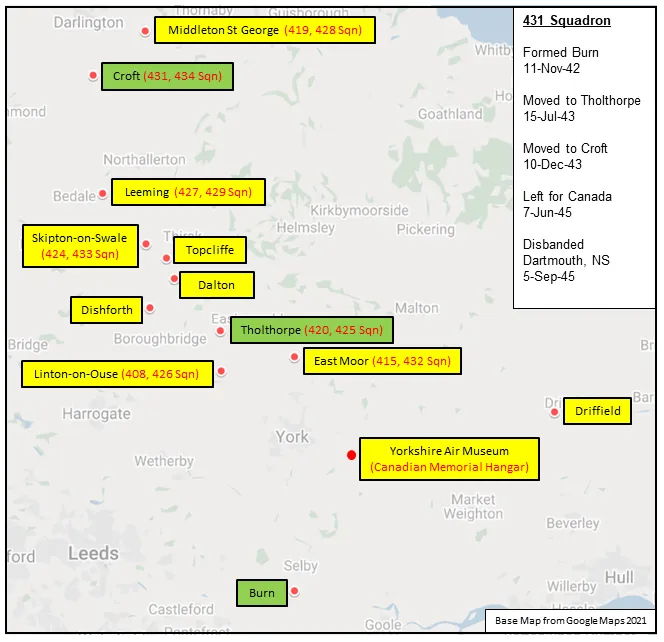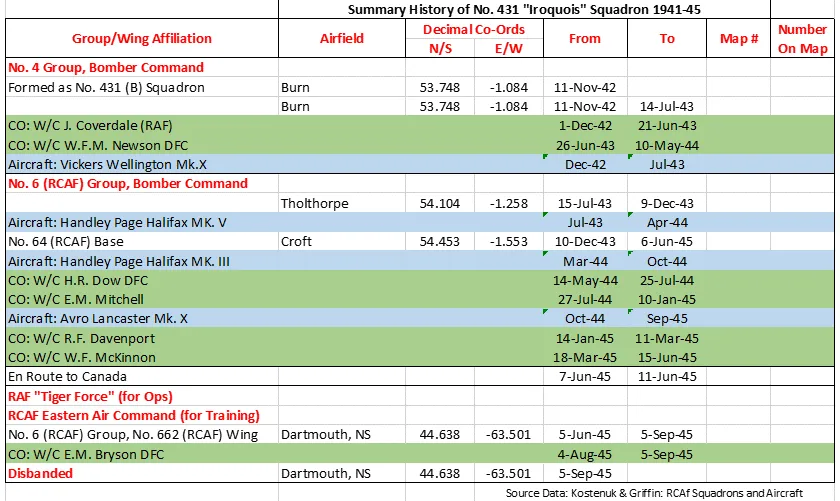De Jong, Gordon Cornelis (Captain)
Killed in Flying Accident 1978-May-03
Service
RCAF
Unit
431 (Snowbirds) Sqn- Squadron
The Hatiten Ronteriios Warriors of the Air: Iroquois
Base
RCAF Stn. Moose Jaw, Saskatchewan
Rank
Captain
Position
Pilot
Service Numbers
Tutor serial: 26118

The Canadair CT-114 Tutor (company model CL-41) was the Royal Canadian Air Force (RCAF), and later Canadian Forces, standard jet trainer between the early 1960s and 2000. It was designed and produced by Canadian aircraft manufacturer Canadair.
Development commenced as a private venture by the company. On 13 January 1960, the prototype performed its maiden flight; a year and a half later, the Canadian Government placed a major order for the type. The RCAF would be the dominant user of the type, but a limited number were exported as well. Specifically, the CL-41G model, which was supplied to the Royal Malaysian Air Force (RMAF), served as a ground-attack aircraft up until its withdrawal.
The Tutor served as the Canadian Forces primary jet trainer from the 1960s up until 2000, at which point it was finally retired from this role, having been replaced by a combination of the newer British-built CT-155 Hawk and American-built CT-156 Harvard II. While the majority of Tutors have been retired, a small handful of aircraft are currently still being used by the RCAF's Snowbirds aerobatics team.
The beginnings of the CL-41 Tutor can be found in a decision by Canadian aircraft manufacturer Canadair to develop its own indigenous trainer aircraft as a private venture. The design itself was the product of the company's in-house Preliminary Design department. By August 1957, the basic configuration of the design had been completed, which was of a turbojet-powered, low-wing aircraft, complete with a tricycle undercarriage and a side-by-side cockpit arrangement. From the onset of development, the aircraft was intended to be a purpose-built trainer for providing elementary jet flight training, as well as additional training up to an advanced level.
The CT-114 Tutor is a single-engine turbojet-powered trainer aircraft. It was purpose-designed for the training role, and possesses numerous favourable qualities, including a high level of reliability and favourable operating economics. It is capable of a wide performance range, possessing a top speed at altitude of 795 kmh (429 kt) and a diving speed of 885 kmh (478 kt) against a relatively low stalling speed of 71kt. The Tutor is furnished with manual flight controls, which incorporate spring tabs. It is intentionally aerodynamically stable in flight, a factor which traditionally has aided in the training of fresh pilots unfamiliar with the demands of flight.
The Tutor features a side-by-side cockpit. During standard operations, the observing instructor was seated on the right-hand side and the flying student pilot on the left; normally, only the left-hand side normally featured full flight controls. However, following experiences with the Snowbirds display team, a number of aircraft were reconfigured with extra controls so that they would be flyable from either position. The cabin, which is fitted with a rear-hinged canopy over both crew members, can be pressurized to a differential of 3 psi (20 kPa), the equivalent to an altitude of about 2,000 m, for pilot comfort.
For aerial display purposes, the Tutor was readily capable of being fitted with a smoke generator, including a pair of under-fuselage pods to house the pressurized diesel fuel used; the use of red dye in the smoke was discontinued fairly quickly as it was found to be highly corrosive. Various other modifications would also be made to display aircraft; these could be routinely installed and uninstalled as airframes would regularly be exchanged between display and training flights.
Aerobatics: During 1967, a batch of ten Tutors were modified for use as a formation aerobatic aircraft by the RCAF (and later the unified Canadian Forces) display team, the Golden Centennaires to celebrate Canada's centennial year. At the end of the 1967 season, the display team was disbanded, thus its aircraft returned to routine training duties. In 1971, a new formation team was formed at 2CFFTS (Two Canadian Forces Flying Training School) at CFB Moose Jaw, once again adopted the type. The following year, the name "Snowbirds" was chosen for the team; during 1978, the team received squadron status as 431 Air Demonstration Squadron.
Since its formation, the Snowbirds display team has regularly performed at air shows and special events, including the annual flypast on Canada Day over the capital city, Ottawa. According to journalist Guy Norris, a defining trait of their aerobatics is the physically-demanding formation flights performed, as well locally-developed manoeuvres such as the "Big Goose'. Unlike most display teams, the Snowbirds do not have a support aircraft; all spares and useful material could be carried by the aircraft themselves in storage areas located in the nose or the wing root.
Those Tutors used by the Snowbirds feature several modifications distinguishing them from standard examples; these include a smoke generating system, an highly-recognisable paint scheme unique to the display team, and a highly-tuned engine for greater responsiveness during low-level flying. Reportedly, display pilots would deliberately fly their aircraft using an above-average level of nose-down trim so that pushing the stick down would become unnecessary. The Snowbirds' aircraft would regularly be cycled with standard training aircraft, allowing the team to operate airframes with comparatively low accumulated flight hours. Wikipedia
Unit Desciption
431 (Snowbirds) Sqn The Hatiten Ronteriios ("Iroquois")
History of the Squadron during World War II (Aircraft: Wellington X, Halifax V, III, Lancaster X)

The Squadron was formed in November 1942 as the RCAF's 11th bomber squadron to be formed overseas, at Burn, Yorkshire, UK ![]() , as a bomber unit of No 4 Group of RAF Bomber Command. With squadron code letters SE it flew Vickers Wellington Mk X aircraft. In July 1943 it moved to Tholthorpe, Yorkshire
, as a bomber unit of No 4 Group of RAF Bomber Command. With squadron code letters SE it flew Vickers Wellington Mk X aircraft. In July 1943 it moved to Tholthorpe, Yorkshire ![]() , to become part of No 6 (RCAF) Group, at the same time re-equipping with Handley Page Halifax Mk V bombers. It moved again in December 1943 to become part of No 64 (RCAF) Base at Croft, Yorkshire
, to become part of No 6 (RCAF) Group, at the same time re-equipping with Handley Page Halifax Mk V bombers. It moved again in December 1943 to become part of No 64 (RCAF) Base at Croft, Yorkshire ![]() , where it remained until the end of the war. Another change of aircraft, to Halifax Mk. III was made in March of 1944, and finally the squadron was equipped with Canadian-built Avro Lancaster Mk X aircraft from October 1944. After the termination of hostilities in Europe, it was earmarked to form part of the Tiger Force to attack Japan and left for Canada in June 1945. The Japanese surrender following the dropping of the atomic bombs made Tiger Force redundant, and the squadron was disbanded at Dartmouth, Nova Scotia
, where it remained until the end of the war. Another change of aircraft, to Halifax Mk. III was made in March of 1944, and finally the squadron was equipped with Canadian-built Avro Lancaster Mk X aircraft from October 1944. After the termination of hostilities in Europe, it was earmarked to form part of the Tiger Force to attack Japan and left for Canada in June 1945. The Japanese surrender following the dropping of the atomic bombs made Tiger Force redundant, and the squadron was disbanded at Dartmouth, Nova Scotia ![]() in September of 1945.
in September of 1945.
In the course of operations the squadron flew 2584 sorties (including 11 bringing PoWs back to England) at a cost of 72 aircraft destroyed. Approximately 14000 tons of bombs were dropped. Aircrew awards were 1 DSO, 63 DFCs, 10 DFMs, 2 CGMs and 1 MiD. Battle Honours were: English Channel and North Sea 1943-44, Baltic 1943-44, Fortress Europe 1943-44, France and Germany 1944-45, Biscay Ports 1943-44, Ruhr 1943-45, Berlin 1943-44, German Ports 1943-45, Normandy 1944, Rhine, Biscay 1944.Moyes, Kostenuk and Griffin
Squadron History (Bomber Command Museum PDF)
Maps for Movements of 431 Squadron 1942-45

431 Squadron History Summary 1942-45

History of the Squadron Post-WWII (Aircraft: Tutor)
No. 431 (Fighter) Squadron re-formed at RCAF Station Bagotville, Quebec ![]() on 18 January 1954, using the new Canadair Sabre. The squadron was formed on a temporary basis until there were enough new CF-100s available to fulfill RCAF squadron needs. No. 431's duties included aerial combat training and displaying the capabilities of jet operations to the public at air shows: the team from No. 431 Squadron consisted of four Sabres and a solo aircraft. This was the first Sabre team to be authorized to perform formation aerobatics in Canada. 431 squadron was disbanded on 1 October 1954.
on 18 January 1954, using the new Canadair Sabre. The squadron was formed on a temporary basis until there were enough new CF-100s available to fulfill RCAF squadron needs. No. 431's duties included aerial combat training and displaying the capabilities of jet operations to the public at air shows: the team from No. 431 Squadron consisted of four Sabres and a solo aircraft. This was the first Sabre team to be authorized to perform formation aerobatics in Canada. 431 squadron was disbanded on 1 October 1954.
In 1969, Colonel O.B. Philp, base commander of CFB Moose Jaw and former leader of the defunct Golden Centennaires aerobatic team, considered using several of the leftover Golden Centennaire CT-114 Tutor aircraft for another team. These Tutors were still fitted for aerobatic flying. Philp, at this point, did not receive approval to form the new team; however, approval had been given for single Tutors to provide simple flypasts at local football games. To further the cause of an aerobatic team, Philp began informal enhanced formation practice for the instructors at 2 Canadian Forces Flying Training School with the aim of providing multi-aircraft flypasts at special events. In 1970, four-aircraft formations began providing flypasts at fairs and festivals, as well as Armed Forces Day at CFB Moose Jaw ![]() . In July 1970, a white Tutor was introduced to the formation for flypasts. Four white Tutors were finally flown together at the Abbotsford Air Show, followed by a flypast in Winnipeg. Known as the "2 Canadian Forces Flying Training School Formation Team", or informally as the "Tutor Whites", the team grew in size to seven aircraft in 1971 using eleven pilots, and gradually gained recognition. Formation flypasts were replaced with more complicated manoeuvres, and more aircraft were added as the team matured. A contest to give the air demonstration team a formal name was held at Bushell Park Elementary School at CFB Moose Jaw, and resulted in the name "Snowbirdsâ€, which was formally adopted on 25 June 1971. The Snowbirds were officially authorized to be designated the "Canadian Forces Air Demonstration Team" on 15 January 1975, and were formed into their own squadron by reactivating 431 Squadron (renamed 431 Air Demonstration Squadron) on 1 April 1978. .Wikipedia
. In July 1970, a white Tutor was introduced to the formation for flypasts. Four white Tutors were finally flown together at the Abbotsford Air Show, followed by a flypast in Winnipeg. Known as the "2 Canadian Forces Flying Training School Formation Team", or informally as the "Tutor Whites", the team grew in size to seven aircraft in 1971 using eleven pilots, and gradually gained recognition. Formation flypasts were replaced with more complicated manoeuvres, and more aircraft were added as the team matured. A contest to give the air demonstration team a formal name was held at Bushell Park Elementary School at CFB Moose Jaw, and resulted in the name "Snowbirdsâ€, which was formally adopted on 25 June 1971. The Snowbirds were officially authorized to be designated the "Canadian Forces Air Demonstration Team" on 15 January 1975, and were formed into their own squadron by reactivating 431 Squadron (renamed 431 Air Demonstration Squadron) on 1 April 1978. .Wikipedia
And the rest is history……………………

